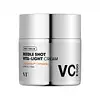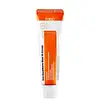What's inside
What's inside
 Key Ingredients
Key Ingredients

 Benefits
Benefits

 Concerns
Concerns

 Ingredients Side-by-side
Ingredients Side-by-side

Water
Skin ConditioningGlycerin
HumectantTocopherol
AntioxidantCaprylic/Capric Triglyceride
MaskingPropanediol
SolventNiacinamide
SmoothingMethyl Trimethicone
Skin ConditioningPentaerythrityl Tetraethylhexanoate
EmollientHydrogenated Poly(C6-14 Olefin)
EmollientCetearyl Alcohol
EmollientPolyglyceryl-3 Distearate
EmulsifyingCetearyl Olivate
1,2-Hexanediol
Skin ConditioningSorbitan Olivate
EmulsifyingAmmonium Acryloyldimethyltaurate/Vp Copolymer
Hydroxyethyl Acrylate/Sodium Acryloyldimethyl Taurate Copolymer
Emulsion StabilisingParfum
MaskingC9-12 Alkane
SolventGlyceryl Stearate Citrate
EmollientAllantoin
Skin ConditioningEthylhexylglycerin
Skin ConditioningCentella Asiatica Extract
CleansingDimethiconol
EmollientAdenosine
Skin ConditioningHydrogenated Lecithin
EmulsifyingSorbitan Isostearate
EmulsifyingSodium Phytate
Ubiquinone
AntioxidantPullulan
Fructooligosaccharides
HumectantAscorbic Acid
AntioxidantSodium Hyaluronate
HumectantEriobotrya Japonica Leaf Extract
Skin ConditioningBeta-Glucan
Skin ConditioningGlutathione
Maltodextrin
AbsorbentMentha Viridis Extract
MaskingPistacia Lentiscus Gum
MaskingNiacin
SmoothingRiboflavin
Cosmetic ColorantBiotin
AntiseborrhoeicCyanocobalamin
Skin ConditioningCarnitine
CleansingCalcium Pantothenate
Thiamine Hcl
MaskingFerulic Acid
AntimicrobialFolic Acid
Skin ConditioningPyridoxine
Skin ConditioningSilica
AbrasiveMadecassoside
AntioxidantMadecassic Acid
Skin ConditioningAsiaticoside
AntioxidantAsiatic Acid
Skin ConditioningPropolis Extract
Skin ConditioningWater, Glycerin, Tocopherol, Caprylic/Capric Triglyceride, Propanediol, Niacinamide, Methyl Trimethicone, Pentaerythrityl Tetraethylhexanoate, Hydrogenated Poly(C6-14 Olefin), Cetearyl Alcohol, Polyglyceryl-3 Distearate, Cetearyl Olivate, 1,2-Hexanediol, Sorbitan Olivate, Ammonium Acryloyldimethyltaurate/Vp Copolymer, Hydroxyethyl Acrylate/Sodium Acryloyldimethyl Taurate Copolymer, Parfum, C9-12 Alkane, Glyceryl Stearate Citrate, Allantoin, Ethylhexylglycerin, Centella Asiatica Extract, Dimethiconol, Adenosine, Hydrogenated Lecithin, Sorbitan Isostearate, Sodium Phytate, Ubiquinone, Pullulan, Fructooligosaccharides, Ascorbic Acid, Sodium Hyaluronate, Eriobotrya Japonica Leaf Extract, Beta-Glucan, Glutathione, Maltodextrin, Mentha Viridis Extract, Pistacia Lentiscus Gum, Niacin, Riboflavin, Biotin, Cyanocobalamin, Carnitine, Calcium Pantothenate, Thiamine Hcl, Ferulic Acid, Folic Acid, Pyridoxine, Silica, Madecassoside, Madecassic Acid, Asiaticoside, Asiatic Acid, Propolis Extract
Hippophae Rhamnoides Fruit Extract 70%
Skin ConditioningGlycerin
HumectantMethylpropanediol
SolventCetyl Ethylhexanoate
EmollientSimmondsia Chinensis Seed Oil
Emollient1,2-Hexanediol
Skin ConditioningNiacinamide
SmoothingPolyglyceryl-3 Methylglucose Distearate
EmulsifyingCetearyl Alcohol
EmollientPhenyl Trimethicone
Skin ConditioningPanthenol
Skin ConditioningSodium Hyaluronate
HumectantPortulaca Oleracea Extract
Skin ConditioningCitrus Unshiu Extract
Skin ConditioningButylene Glycol
HumectantAdenosine
Skin ConditioningSorbitan Stearate
EmulsifyingGlyceryl Stearate Se
EmulsifyingMethyl Methacrylate Crosspolymer
Carbomer
Emulsion StabilisingArginine
MaskingAmmonium Acryloyldimethyltaurate/Vp Copolymer
Water
Skin ConditioningCaprylyl Glycol
EmollientEthylhexylglycerin
Skin ConditioningDisodium EDTA
Hippophae Rhamnoides Fruit Extract 70%, Glycerin, Methylpropanediol, Cetyl Ethylhexanoate, Simmondsia Chinensis Seed Oil, 1,2-Hexanediol, Niacinamide, Polyglyceryl-3 Methylglucose Distearate, Cetearyl Alcohol, Phenyl Trimethicone, Panthenol, Sodium Hyaluronate, Portulaca Oleracea Extract, Citrus Unshiu Extract, Butylene Glycol, Adenosine, Sorbitan Stearate, Glyceryl Stearate Se, Methyl Methacrylate Crosspolymer, Carbomer, Arginine, Ammonium Acryloyldimethyltaurate/Vp Copolymer, Water, Caprylyl Glycol, Ethylhexylglycerin, Disodium EDTA
Ingredients Explained
These ingredients are found in both products.
Ingredients higher up in an ingredient list are typically present in a larger amount.
1,2-Hexanediol is a synthetic liquid and another multi-functional powerhouse.
It is a:
- Humectant, drawing moisture into the skin
- Emollient, helping to soften skin
- Solvent, dispersing and stabilizing formulas
- Preservative booster, enhancing the antimicrobial activity of other preservatives
Adenosine is in every living organism. It is one of four components in nucleic acids that helps store our DNA.
Adenosine has many benefits when used. These benefits include hydrating the skin, smoothing skin, and reducing wrinkles. Once applied, adenosine increases collagen production. It also helps with improving firmness and tissue repair.
Studies have found adenosine may also help with wound healing.
In skincare products, Adenosine is usually derived from yeast.
Learn more about AdenosineAmmonium Acryloyldimethyltaurate/Vp Copolymer (let's call it AAVC for short) is a synthetically created polymer. It's used as a film-forming agent and used to thicken the consistency of products.
AAVC is able to increase the consistency and viscosity of products due to its large molecule size. It also prevents ingredients from separating.
Cetearyl alcohol is a mixture of two fatty alcohols: cetyl alcohol and stearyl alcohol. It is mainly used as an emulsifier. Emulsifiers help prevent the separation of oils and products. Due to its composition, it can also be used to thicken a product or help create foam.
Cetearyl alcohol is an emollient. Emollients help soothe and hydrate the skin by trapping moisture.
Studies show Cetearyl alcohol is non-toxic and non-irritating. The FDA allows products labeled "alcohol-free" to have fatty alcohols.
This ingredient is usually derived from plant oils such as palm, vegetable, or coconut oils. There is debate on whether this ingredient will cause acne.
Due to the fatty acid base, this ingredient may not be Malassezia folliculitis safe.
Learn more about Cetearyl AlcoholEthylhexylglycerin (we can't pronounce this either) is commonly used as a preservative and skin softener. It is derived from glyceryl.
You might see Ethylhexylglycerin often paired with other preservatives such as phenoxyethanol. Ethylhexylglycerin has been found to increase the effectiveness of these other preservatives.
Glycerin is already naturally found in your skin. It helps moisturize and protect your skin.
A study from 2016 found glycerin to be more effective as a humectant than AHAs and hyaluronic acid.
As a humectant, it helps the skin stay hydrated by pulling moisture to your skin. The low molecular weight of glycerin allows it to pull moisture into the deeper layers of your skin.
Hydrated skin improves your skin barrier; Your skin barrier helps protect against irritants and bacteria.
Glycerin has also been found to have antimicrobial and antiviral properties. Due to these properties, glycerin is often used in wound and burn treatments.
In cosmetics, glycerin is usually derived from plants such as soybean or palm. However, it can also be sourced from animals, such as tallow or animal fat.
This ingredient is organic, colorless, odorless, and non-toxic.
Glycerin is the name for this ingredient in American English. British English uses Glycerol/Glycerine.
Learn more about GlycerinNiacinamide is a multitasking form of vitamin B3 that strengthens the skin barrier, reduces pores and dark spots, regulates oil, and improves signs of aging.
And the best part? It's gentle and well-tolerated by most skin types, including sensitive and reactive skin.
You might have heard of "niacin flush", or the reddening of skin that causes itchiness. Niacinamide has not been found to cause this.
In very rare cases, some individuals may not be able to tolerate niacinamide at all or experience an allergic reaction to it.
If you are experiencing flaking, irritation, and dryness with this ingredient, be sure to double check all your products as this ingredient can be found in all categories of skincare.
When incorporating niacinamide into your routine, look out for concentration amounts. Typically, 5% niacinamide provides benefits such as fading dark spots. However, if you have sensitive skin, it is better to begin with a smaller concentration.
When you apply niacinamide to your skin, your body converts it into nicotinamide adenine dinucleotide (NAD). NAD is an essential coenzyme that is already found in your cells as "fuel" and powers countless biological processes.
In your skin, NAD helps repair cell damage, produce new healthy cells, support collagen production, strengthen the skin barrier, and fight environmental stressors (like UV and pollution).
Our natural NAD levels start to decline with age, leading to slower skin repair, visible aging, and a weaker skin barrier. By providing your skin niacinamide, you're recharging your skin's NAD levels. This leads to stronger, healthier, and younger looking skin.
Another name for vitamin B3 is nicotinamide. This vitamin is water-soluble and our bodies don't store it. We obtain Vitamin B3 from either food or skincare. Meat, fish, wheat, yeast, and leafy greens contain vitamin B3.
The type of niacinamide used in skincare is synthetically created.
Learn more about NiacinamideSodium Hyaluronate is hyaluronic acid's salt form. It is commonly derived from the sodium salt of hyaluronic acid.
Like hyaluronic acid, it is great at holding water and acts as a humectant. This makes it a great skin hydrating ingredient.
Sodium Hyaluronate is naturally occurring in our bodies and is mostly found in eye fluid and joints.
These are some other common types of Hyaluronic Acid:
Learn more about Sodium HyaluronateWater. It's the most common cosmetic ingredient of all. You'll usually see it at the top of ingredient lists, meaning that it makes up the largest part of the product.
So why is it so popular? Water most often acts as a solvent - this means that it helps dissolve other ingredients into the formulation.
You'll also recognize water as that liquid we all need to stay alive. If you see this, drink a glass of water. Stay hydrated!
Learn more about Water